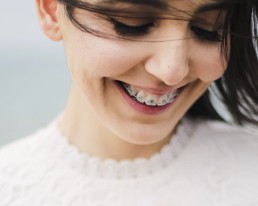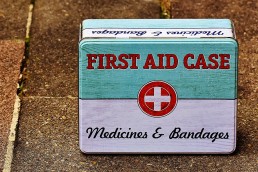7 Reasons Your 7-Year-Old Should See a Pediatric Orthodontist
While seven years old may seem too young to start orthodontic treatment, it is the perfect age for an initial consultation with a pediatric orthodontist. Not only does the American Association of Orthodontists recommend that age to make your first appointment, we also believe it’s the right time to create a plan for a healthy orthodontic future.
Still not buying it? Consider these seven reasons for scheduling your first orthodontist appointment by age seven:
#1: Proactive Treatment by Pediatric Orthodontist
Seeing a pediatric orthodontist ensures the proper alignment of your child’s jaws — a more complicated process after the jaws and teeth have finished growing. Proactive treatment also helps to correct bad oral habits, guide permanent teeth into a more desirable position, improve appearance, and enhance self-esteem.
What You Need to Know When Looking for a Children’s Orthodontist
#2: The Emergence of Permanent Teeth
By age seven, your child most likely has enough permanent teeth for us to decide the need for orthodontic care and the best treatment options to consider.
#3: Catch Bad Habits Early
Orthodontists are able to identify bad habits — such as thumb sucking — and the effects they have on your child’s teeth and mouth. Seeing an orthodontist at an early age can help prevent these bad habits from worsening and improve the orthodontic experience. Some bad habits, if left untreated, can lead to the need for future extractions or even jaw surgery.
#4: Less Invasive and More Cost Effective
If your child starts orthodontic treatment from an early age, the treatment tends to be less invasive and more cost effective. Your child’s permanent teeth are still growing at this time, which means early orthodontic work can identify issues early and begin treatment before those issues worsen.
#5: Avoid Issues That Emerge From Adult Teeth
There are some issues that are treated much more easily in childhood than adulthood. As permanent teeth are still coming in, orthodontists can identify how they are coming through the gums and evaluate if treatment is needed to properly allow permanent teeth to emerge.
#6: Make a Financial Plan for the Future
Understanding all of your orthodontic options from an early age helps you budget for the future. Treatment plans could include different types of appliances at different stages, all requiring varying costs. Early orthodontic visits can set an orthodontic treatment plan that works within your financial limitations.
#7: More Favorable Long-Term Results
The earlier you can identify orthodontic issues and start treatment, the better your results will be. If treatment begins before the jaw finishes growing, results are typically faster, cheaper and better overall. The best part? Proper orthodontic treatment improves your child’s personal appearance and, in may cases, boosts his or her self-confidence.
It is important to start orthodontic treatment early, in order to ensure a healthy smile that looks and feels good. Since our jaws grow at different rates, receiving an initial consultation will give you plenty of information for creating an effective treatment plan with your orthodontist.
Our team at Gorman and Bunch Orthodontics is committed to helping you achieve the healthiest smile possible. Schedule a free consultation today, and start your path to a happier smile. We look forward to hearing from you!
Ready to schedule a free consultation?
How to Find the Best Orthodontist Near You
Choosing the best orthodontist near your home or office can be an overwhelming task. Your teeth are a sensitive subject (no pun intended), and orthodontic treatment has the potential to be a long and costly process. You want to build trust early on with your orthodontist, as you are putting the fate of your smile in his or her hands!
To help you in the decision making process, here are several things to consider when searching for the best orthodontist near you who is right for your needs:
Experience and Qualifications of the Orthodontists
When researching orthodontists, look for what qualifications and experiences they have. Orthodontists require a certain level of higher education, including a bachelor’s degree, a doctor of dental surgery degree, and additional training in orthodontics. Orthodontists can also become Board Certified, which isn’t required but adds a higher level of training and experience. Before choosing an orthodontist, do your research online or by calling the office to determine if he or she has the proper experience and qualifications.
Invisalign vs Braces Cost
Cost is can be a barrier when choosing whether or not to visit an orthodontist. There are many options for braces today, and treatment is a significant financial investment. Ask an orthodontist for complete information on payment options and insurance coverage before starting treatment. Make sure you understand all of the fees associated with your treatment, as well as any payment plans that might be available. Every orthodontic case is different, so be sure to understand the full scope of your specific treatment plan.
What does an orthodontist do?
Orthodontic Treatment Options
From metal braces to Invisalign, there are a wide range of orthodontic treatment options available today for straightening your teeth. Before making your first appointment, figure out what treatment options that orthodontic office offers to help you ask better questions about the options during your initial consultation.
Dentist Referrals
Ask family and friends in your community about their experiences with orthodontists in your city. Better yet, ask your dentist who he or she suggests. It’s important to work with an orthodontic practice that not only has the skills and experience necessary, but is also pleasant to work with and has nothing but good intentions. Your dentist should also have recommendations for you.
Location and Office Hours
While you shouldn’t choose an orthodontist solely based on the location of the office, this is an important factor as you’ll be going to many appointments over the course of your treatment plan. Additionally, you should always ask about office hours, to ensure that they are manageable with your school or work schedule.
Free Orthodontic Consultation
Most orthodontists offer free orthodontic consultations, in order to do an initial examination, take digital x-rays and photos and discuss treatment options to see if you are ready for orthodontic treatment. If you’re looking at an orthodontic office that doesn’t offer this initial free consultation, we’d recommend you go in a different direction. It’s important that you are fully informed about the process before making a final decision.
Office Environment of Best Orthodontist Near You
Orthodontic treatments can last anywhere from 1-3 years (or more), which is a significant amount of time to spend inside an office. Take advantage of that free consultation, and visit the offices you are considering. You want to feel relaxed and comfortable inside your orthodontist’s office.
We also suggest meeting the rest of the team — such as clinical assistants and scheduling coordinators — during your initial consultation, as you will be working with the staff a significant amount. Are they friendly and approachable? Can they confidently answer your questions? Take time to learn their qualifications as well, and make sure you feel supported and listened to in that office environment.
If you’ve been considering visiting an orthodontist to straighten your smile, and you’re curious about Gorman & Bunch Orthodontics, here are the next steps we suggest.
- Meet our staff.
- See our orthodontic treatments.
- Peruse our payment options.
- Check out our seven Central Indiana offices — including our newest in Fishers.
- Read our blog for more info on Invisalign vs braces.
- Schedule your free orthodontic consultation.
Before making a final decision on the best orthodontist near you, make sure you receive as much orthodontist information as possible. We look forward to hearing from you!
Ready to schedule a free consultation?
3 Types of Braces for Teens
In our practice, we frequently outfit teenagers with braces. It’s the ideal age — between 12 and 16 — to start orthodontic treatment because the teeth can be more easily positioned into a straighter smile.
Braces can solve a number of issues, including overcrowded teeth, gaps between teeth, overbites, underbites and crossbites. Fixing these issues is not only beneficial to your health, but can also improve your smile and boost your overall confidence and happiness levels.
Once you and your teen make a decision to move forward with braces, you then have several types of braces to choose from to straighten your teeth.
What foods should you avoid eating with braces?
Metal Braces
Metal braces are what you think of when you picture the traditional style of braces. They are made from metal brackets and connected by a thin archwire that pushes and pulls your teeth slowly into the right position. The archwire connects to the brackets using ligatures, which are referred to as elastics or o-rings.
These elastics come in fun colors that each patient gets to choose during visits to one of our seven offices. Metal braces do not require as much patient compliance as other options, however, they are also the most noticeable option.
Ceramic (Transparent Braces)
Ceramic braces are very similar to metal braces, except the brackets are made from a clear, transparent, ceramic material. This material is much less noticeable than metal brackets.
Invisalign Teen (Nearly Invisible Braces)
As the number one local Invisalign provider, we see more and more teenagers choosing these barely visible braces that many consider as an alternative to braces for teens. With Invisalign Teen, we first take impressions of your teeth and then give you a series of clear, removable aligners that you change every one to two weeks to slowly reposition your teeth.
It’s worth noting that not all of these types of braces for teens are available to all our patients in this age group. The Gorman & Bunch Orthodontics staff would love to meet for a complimentary consultation where we can access your teenager’s smile, share the prices for braces for teenagers, and offer our recommendations.
Ready to schedule a free consultation?
10 Bad Habits You May Be Making With Your Braces
While most people understand that chewing gum is off limits with braces, there are several other bad habits that patients with orthodontic treatment should know about. Some of these habits should also be avoided after orthodontic treatment is complete, as they will affect your overall oral hygiene. Unfortunately, teeth are not as strong as we sometimes think, and certain habits can cause a shift shift your teeth, poor oral health, or damaged braces.
Whether you have traditional orthodontic braces or Invisalign, it’s absolutely necessary to care for your teeth. Here are 10 of the most common bad habits to avoid with braces.
1. Using Your Teeth as a Tool
Trying to open a bag of chips with your teeth may not only chip a tooth, but could also damage the brackets on your braces. Additionally, it could force your teeth to shift out of the proper alignment we’ve worked so hard to achieve. Find those scissors instead!
2. Chewing on Items That Are Not Food
We’ve all been there — catching ourselves chewing on straws, pencils, pens, or other random objects you may encounter at school or at work. But chewing on items that aren’t food can cause your teeth or brackets to chip, break and shift. Your braces aren’t designed to have constant pressure applied to them, so try your best to limit your chewing to meals and snacks.
What Foods to Avoid Eating
3. Biting Your Nails
Although we could put this under “chewing on things that are not food,” we’re giving it its own category because we know how many people suffer from this bad habit. Biting your nails can bend wires and break brackets. It can also damage your actual teeth. Ultimately, excessive nail biting will force your teeth out of alignment, which defeats the purpose of getting braces all together!
4. Sucking Your Thumb
For many, thumb sucking starts at a young age and lasts into adolescence, resulting in the misalignment of your teeth and making braces necessary in most cases. In order to rid yourself or your child of this bad habit, try dousing the thumb in a bitter-tasting solution or wrapping the thumb in cloth.
5. Brushing Your Teeth Too Hard
Some people mistakenly think that the harder you brush your teeth, the cleaner they will be. However, brushing your teeth too hard can damage the delicate tissue on your gums, which may result in soreness, pain, bleeding, and receding gums. Bad brushing habits can also damage your braces by forcing your brackets to come off.
6. Snacking on Ice
We know how tempting it is to munch on ice toward the end of a cold drink. But the coldness and hardness of ice makes it very threatening to your teeth and braces. Ice can easily damage your wires and brackets, as well as be painful.
7. Drinking Dark-Colored Beverages
Darker drinks, such as coffee, soda, red wine and black tea, can stain your teeth around your brackets, as well as your elastic ties. We suggest using a straw while drinking these beverages, or rinsing your mouth out with water and/or mouthwash after drinking them.
8. Consuming Too Much Sugar
Did you know the average American eats three times the amount of sugar per day than what’s recommended? Sugar leaves an acidic film in your mouth that eats away at your teeth and gums. Soda and fruit juices are especially high in acidic properties and are extra harmful for your teeth. Consuming these beverages makes it much more difficult to clean your teeth thoroughly with braces, making you more susceptible to cavities.
9. Eating Sticky Foods
This may be the most important habit to break if you have braces. Sticky foods can easily bend your wires and even break off your brackets. These foods can also get stuck in your braces and significantly increase your chance of cavities. “Sticky” foods include gum, caramel, taffy, candies, and more.
10. Pushing Back Your Orthodontist or Dentist Visits
We strongly recommend visiting your dentist every six months, and sticking to the schedule your orthodontist has put in place for your treatment plan. Putting off your appointments may give cavities the opportunity to grow or turn small orthodontic issues into big problems. Sticking to your appointments will help prevent major dental work and orthodontic procedures that may not be necessary with regular checkups.
Breaking these habits will help you straighten your teeth and improve your smile. If you’re a parent, it’s important to recognize if your kids are engaging in these bad habits and encourage them to quit. If you’re looking for guidance, don’t hesitate to reach out to us with questions, we’re always happy to help you get a straighter smile!
Ready to schedule a free consultation?
The Importance of Flossing While We Straighten Your Teeth
Here at Gorman & Bunch Orthodontics, we believe that good oral hygiene is important at all times — even more so during orthodontic treatment — and that includes brushing and flossing your teeth.
How Flossing Can Improve Your Smile
Neglecting to floss during orthodontic treatment puts you at an increased risk for dental cavities, tooth decay and gum disease. Taking special care for your teeth while wearing braces will pay off in the long run. Otherwise, you may experience the issues below.
Demineralization
Your braces create new areas where bacteria and food particles can get stuck in your mouth. These substances can cause serious decay, which is why it’s so important to floss with braces. Allowing plaque to build up on the teeth may cause scarring and decay to occur.
Delayed Completion Time
It’s important to keep your braces clean during your treatment time. Bacteria, sugar and food build-up can damage your braces, making it easier for the brackets to be moved out of place so they are no longer attached. Poor dental health during orthodontic treatment could result in tooth decay, gum disease and broken brackets, which will slow down your treatment schedule.
Aches and Pains:
Unhealthy teeth may cause a negative experience in which you feel pain, aches or sensitivity caused by cavities and decay.
Stained Teeth
Bad oral hygiene can result in stained teeth, instead of a bright white and beautiful smile once your braces are removed.
See Our Recommendations on Best Toothbrushes and Toothpaste
Tips on Flossing While You Get a Straighter Smile
Flossing is one of the best ways to ensure healthy oral hygiene during your orthodontic treatment. While it can be tricky, it’s not impossible. Below are some tips and tricks for making flossing with braces easier:
Use the Right Tool
Invest in an orthodontic floss threader, which is a disposable tool that allows you to pull the floss through your teeth above the wire and reach your gum line. We will give you a packet of these when we place your braces, but if you run out you can find them at any pharmacy.
Use Waxed Floss
Unwaxed floss can catch on your braces and leave behind shreds of floss. Instead, use waxed floss along with your floss threader, which will slip much more easily between each tooth.
Know Where to Floss
As you floss between your teeth like you normally would without braces, make sure you also floss behind your wires to remove food particles that can get stuck.
Go Beyond the Floss
Consider using a waterpik and/or electric toothbrush to help remove loose food particles or harmful bacteria that may be lingering in your mouth.
Flossing is an essential part of maintaining good oral hygiene during orthodontic treatment. Braces may hold food, sugars and liquids after eating and flossing will help you achieve the beautiful smile you’re seeking.
As always, give us a call if you have any questions about flossing during your orthodontic treatment. We’re here to help you achieve the best smile possible!
Ready to schedule a free consultation?
How to Handle Orthodontic Emergencies With Your Braces
Although it is rare for orthodontic emergencies to happen, they do occur from time-to-time. It’s important to remember that if your bracket is loose or if one of your wires is sticking out, you don’t have to come to the office right away unless you are in pain or experiencing severe discomfort. Instead, you may be able to fix it yourself.
Below, we’ve outlined the ways to treat some orthodontic emergencies with your braces at home.
1. Loose or Broken Bracket
This could occur if you eat hard food or play with your braces too much. If it happens and you aren’t experiencing any pain or discomfort, simply leave the bracket in place and cover it with wax if needed, until your next scheduled appointment. If your bracket pops off completely, please bring it with you to your next appointment and call ahead to let us know.
2. Poking Wires
Sometimes, your wires may stick out and irritate your cheeks. When you first get your braces, make sure you aren’t experiencing this problem before you leave our office. But if the irritation starts later, you may be able to push the wire back inside your molar tube with a pencil eraser, cotton swab, or ball of wax. You could also attempt to use clean nail clippers and rubbing alcohol to cut the wire yourself. If the irritation persists, give us a call.
Avoid These 10 Bad Habits While Wearing Braces
3. Discomfort or Soreness
It is common for your teeth to become sore after we place your braces, lasting about a week at most. Be sure to continue eating soft foods and chewing only sugarless gum. This may be uncomfortable at first, but chewing actually increases bloodflow to your teeth and will help reduce discomfort.
4. Completely Disconnected Wire
If this happens, you can try to push it back into the tube using your hands or tweezers. If that doesn’t work, try using clean nail clippers to cut the wire as close as you can to the next bracket. But if it continues to bother you before your next scheduled appointment, give us a call.
5. Broken Elastics
If one of your elastics breaks and you don’t have any extras, give us a call. We’ll let you know if you need to come in and get a new one right away, or if you can wait until your next appointment.
6. Lost Retainers
Call the office immediately if you lose or break your retainer. You’ll need to schedule two additional appointments, one to get an impression taken, and another one to insert your new retainers.
7. Traumatic Event—Call Us Immediately
If a traumatic event like a fall or blow to the face happens, you may need immediate care. In these situations, X-rays are often necessary to determine the extent of the injury and whether or not the orthodontic appliances have been damaged. Teeth may change their position and sometimes the bone surrounding the teeth is damaged. If a traumatic event occurs, contact your orthodontist as soon as possible.
Knowing what to do in an orthodontic emergency can make your experience with braces way more pleasant. In most cases, the solutions are simple and something you can do at home. The more educated you are, the more comfortable you or your kids will be in dealing with these emergencies.
As always, don’t hesitate to reach out if you have any questions! We’re happy to help.
Ready to schedule a free consultation?
What Foods to Avoid With Braces?
Whether you are new to braces or well into your orthodontic treatment plan, it’s very important that you are conscious of what you eat. Although braces are extremely sturdy and stable, they need to be treated with care by eating foods that are gentle on your brackets and wires. By eating the right things now, you can ensure a healthier smile later. That’s why we’ve put together a list of foods to avoid with braces.
Foods to Avoid With Braces
During your first few days with braces, stick to only eating soft foods. It only takes one bad bite to damage your braces and prolong your orthodontic treatment. For the remainder of your orthodontic treatment plan, follow this list of foods to avoid with braces as much as possible:
- Crunchy foods like partially popped popcorn kernels, ice, pretzels, hard cookies, and chips.
- Sticky foods like caramels, chocolate, sugary gum, and candy.
- Chewy foods like bagels and licorice.
- Hard foods like pizza crust, whole carrots, candy, nuts and taco shells.
- Also avoid chewing on pens, pencils, fingernails and especially ice. These can all damage your braces and prolong treatment.
Additionally, avoid biting into hard foods with your front teeth. Consider cutting up these foods, or better yet, avoid them completely:
- Raw vegetables
- Croutons
- French/Italian bread and pizza crust
- Meat on the bone
- Corn on the cob
- Apples
- Carrots
In addition to avoiding hard foods, it’s also important to avoid chewing on hard items such as pens, pencils and fingernails. These things can damage your braces, and when a bracket comes loose and is no longer attached to your tooth, that tooth is no longer moving in the right direction. It could actually be moving in the wrong direction, back to where it started. Loose and broken braces can cause treatment to last longer, so contact your orthodontist as soon as you notice something is off.
Check Out These 5 Healthy and Delicious Foods You CAN Eat With Braces
Foods You CAN Eat When Wearing Braces
While the list above may seem never ending, don’t panic! We’ve also put together a list of tasty foods you are able to eat safely with braces:
- Soft Fruits, like blueberries, grapefruits, nectarines, kiwi, bananas, grapes, and tangerines
Steamed Vegetables (so they’re softer) - Dairy Products, like yogurt and cheese.
- Soft Grains and Noodles, like mac and cheese, cooked ravioli, quinoa, and rice
- Soft Meats, like tender chicken, turkey, meat loaf, lunch meat, and seafood
- Eggs, which are a good alternative to tough meats.
- Desserts, like pudding, applesauce, smoothies, and ice cream.
- Soft Breads, like tortillas, biscuits, muffins, pancakes.
- Snacks, like soft crackers or cookies, peanut butter and jelly sandwiches, and hulless popcorn.
Pro Tip: The healthier you are, the better results you will see. A proper diet provides the essential nutrients required to sustain strong bones and tissues that are undergoing change under braces.
Paying attention to what you’re eating is essential to protecting and preserving your smile. By following our list of foods to avoid with braces and cleaning your teeth regularly, you’ll be on track to a healthier and happier smile in no time.
And as always, please don’t hesitate to reach out to us with any questions you may have about your orthodontic treatment plan. We’re here to help!
Ready to schedule a free consultation?
5 Tips for Surviving Your First Week With Braces
So, you say you’re getting braces. Congratulations! Those braces will get you one step closer to the beautiful smile you’ve always wanted. Leading up to the big day, you probably have lots of questions about how to prepare for the appointment, what to eat the first week of braces, and how to manage braces pain that first week.
The hardest part of getting new braces can be enduring the first week. Your body is just getting used to these strange, new pieces of metal in your mouth, and you likely feel a bit sore at first. Once you get through that first week, though, you’re well on your way to a beautifully straight smile.
In order to help you feel more comfortable in your new braces, we’ve compiled a list of five tips for braces that will get you through the first week.
1. Be Prepared Before Leaving Our Orthodontics Office
After getting your braces, don’t leave the office until you’ve talked to us about the following items:
Check Wire Ends
Use your finger and tongue to make sure the wires aren’t extending into areas that might poke your cheeks or run into your tongue the wrong way.
Understand Next Steps
Make sure you ask plenty of questions to make sure you know what you’re supposed to do before your next appointment, which could include wearing headgear, using elastics, following specific hygiene recommendations, and more.
Double Check Your Supplies
Ask your orthodontist for plenty of dental wax, cleaning aids, elastic bands or other related materials you may need before your next appointment.
How should you handle orthodontic emergencies with your braces?
2. Foods to Avoid With Braces
Believe it or not, the most common questions we receive from patients have to do with how to eat with braces. You’ll probably want to know how long after getting braces can you eat solid food. It’s okay to eat as soon as you leave the office, but we highly suggest you only eat soft foods the first few days while your mouth and teeth adjust. Stick to pasta, seedless bread, soft veggies, pudding, soup, yogurt, etc.
Wondering what to eat with braces the first week? We can help with that, too! After about 3-4 days, the soreness will start to go away and you can graduate to more solid foods, but always steer clear of those foods on the “do-not-eat list,” as they could cause damage to your teeth and braces.
3. Use Wax to Fight Sores in Your Mouth
Brackets and wires are designed to be gentle on your mouth, but they can rub on the soft skin in your mouth and cause irritation while you’re still getting used to them, especially on your first day with braces. Over time, your skin will toughen, and you won’t continue to get sore spots. Until then, it’s a good idea to use the wax we provide to ease any discomfort.
4. Rinse Your Mouth With Saltwater
If you’re experiencing significant irritation, we suggest rinsing your mouth out with a solution of warm salt water for 30 seconds and 5-6 times per day. Just add half a teaspoon of table salt to one cup of warm water. The salt water will help relieve pain and allow sores areas to heal faster.
5. Always Practice Good Oral Hygiene
Use the toothbrush we provide to clean your teeth after every meal, taking extra care to clear away every bit of food that might get stuck in your brackets. Don’t forget to follow your normal routine of brushing your teeth twice a day and flossing on a regular basis. Getting into these habits early on in your journey with braces will ensure that you don’t encounter any problems down the road.
Each person adapts to the discomfort associated with new braces differently, but if you follow these five braces tips then you’ll experience a much more comfortable path to straight teeth. Once you make it past these first few days, it’ll be smooth sailing, and you won’t even notice that you have braces on!
We hope these tips on surviving and knowing what to eat the first week with braces was helpful! As always, please don’t hesitate to reach out to us with any questions you may have about your orthodontic treatment plan.
Ready to schedule a free consultation?
Gorman & Bunch Orthodontics Opens 2 Central Indiana Offices
In 1962, my father—Dr. Jack Gorman—opened his orthodontic office in Marion, Indiana. And then 27 years later, I was honored to join the practice and work alongside him.
Many things have changed since those early days—both in the field and in our practice—but what’s never wavered is our commitment to serving families in Central Indiana. From day one, we’ve always enjoyed helping kids and adults smile in this area.
And that’s what makes me most excited to share that we’ve now expanded the Gorman & Bunch Orthodontics practice to seven locations across Central Indiana. Now we’ll get to bring even more smiles to the greater Indianapolis area!
New Orthodontic Offices in Northern Suburbs of Indianapolis
Joining our other offices in Carmel, Westfield, Kokomo, Marion, and Wabash, we’ve now added two new offices in the near northwest and northeast suburbs of Indianapolis.
WEST CARMEL/ZIONSVILLE
3965 W 106th St., Suite 150
Carmel, IN 46032
P: (317) 471-0100
E: [email protected]
MAP IT
LAWRENCE/MCCORDSVILLE
10820 Pendleton Pike, Suite B
Indianapolis, IN 46236
P: (317) 561-6470
E: [email protected]
MAP IT
The West Carmel/Zionsville office sits just east of the U.S. 421 (Michigan Road) and 106th Street intersection, while our new Lawrence/McCordsville office sits just west of the corner of 59th Street and Sunnyside Road.
New Doctor to Join Gorman & Bunch Orthodontics Practice
As part of this expansion, we’re also excited to announce the addition of Dr. David Judy, DDS, MS, who is joining our Gorman & Bunch Orthodontics team in the West Carmel/Zionsville office.

Since 1994, Dr. Judy has been creating great looking smiles in Indianapolis, and, like us, committing himself to treating his patients with only the highest level of care, compassion, and respect. Dr. Judy earned his Bachelor of Arts degree from Indiana University and his Doctor of Dental Surgery degree from Indiana University School of Dentistry. He has published several works and lectured on various orthodontic topics throughout his 20-year orthodontic career. Additionally, he has also served as Lieutenant Colonel from the U.S. Army Dental Corps.
We’re so grateful for Dr. Judy’s service to his profession and our country, and we’re honored to have him join our family. We’re also looking forward to Dr. Carly Ahlbrecht leading the growth of our new Lawrence/McCordsville office.
As always, feel free to contact us with any questions you may have about these changes. We look forward to seeing you in any of our seven offices across Central Indiana!
Ready to schedule a free consultation?
How We Straighten Teeth With Braces
Last month, we told you how healthy, straight teeth can give you a better, healthier heart. And while brushing, flossing and rinsing can keep your teeth healthy, we also believe you need the assistance of a well-trained orthodontist and treatment plan to actually do the straightening. We’re known locally for our Invisalign treatment, but many Gorman & Bunch Orthodontics’ patients also choose braces. So how do we straighten teeth with braces? Great question! Read on to find out how braces work, when to expect results, and how to get started on your journey to a straight, beautiful smile.
The Components of Braces
First, let’s discuss the pieces and parts in a full set of braces that work to straighten your teeth.
Brackets
These are made of metal or ceramics. We use dental bonding material — really strong glue that keeps the brackets in place over the course of your treatment — to attach them to each tooth.
Archwire
This is the thin metal wire that runs between each bracket and puts pressure on your teeth in order to become aligned or straightened — whether it’s up and down or side to side.
Elastic Ties
The elastic ties — also known as elastic rings, ligature elastics, or donuts — hold the archwire to the brackets. Our patients love these pieces because they come in an endless variety of colors! Customizing your smile is just one perk of braces for teeth. Each time you come into one of our Central Indiana offices to get your braces adjusted, you get to choose a new style.
Rubber Bands
Depending on your bite, we may use rubber bands or elastics that hook from a bracket on the upper teeth to a bracket on the lower teeth. These create additional pressure to straighten and direct your teeth and jaw into proper alignment.
In some cases, there are other tools we may use during your treatment time, such as tubes, hooks, loops, springs, steel ties, and headgear. But don’t worry, we’ll keep you informed every step of the way.
Why is it so important for you to floss your teeth while in braces?
The Process of Aligning Your Teeth With Braces
Now that you know the ins and outs of braces components, you’re probably asking yourself, “How do braces work?” Your braces do more than rearrange your misaligned teeth. In fact — through a process called bone remodeling — we apply constant, gentle pressure against your teeth that actually encourages your bones to adapt and hold your teeth in their new positions for the rest of your life.
Here’s how it works. The bracket and archwire work together to align each tooth into proper position. When we first place your braces, we use a narrow, flexible archwire, as your teeth ease into the new force and pressure. Then, as your teeth become straighter, we eventually use thicker archwires that fill more of the brackets’ slots and provide additional pressure.
Once your teeth move to the right spot, we hold your teeth in place while the bone tissue around your teeth and jaws changes. And voila, your new and improved smile is set in place!
How Long it Takes for Braces to Straighten Your Teeth
The most popular question we hear from our patients is, “how long do braces take to create a straight smile?” It usually talks about three days for the bone remodeling process to start. You may feel some soreness in your mouth the first few days or weeks as your teeth and jaw get used to this new pressure as braces move your teeth a little everyday. As far as when teeth start to straighten with braces, once the process is in place, it takes about three months to grow new bone, and then generally 1-3 years to fully stabilize. This is why it’s so important to wear a retainer!
Exactly how fast teeth move with braces depends on each patient. But, there are things you can do to help the process. Proper dental hygiene during your treatment will make your individual process the most efficient. Flossing between each bracket is extremely important, as well as brushing every curved angle around gums and brackets. We, of course, discourage chewing hard candy and gum (unless it’s sugar-free gum), and encourage eating some foods in smaller bites, like slicing an apple instead of biting into it directly.
Getting Started With Braces at Gorman & Bunch Orthodontics
We follow the American Association of Orthodontics guidelines that recommend an orthodontic evaluation for every child by age seven or sooner. Our First Phase Evaluation helps us determine the best time to begin any necessary treatment and allow us to watch growth patterns as your child develops, and gives us a chance to explain how we straighten teeth with braces.
If you think you or a family member are ready to talk about orthodontic treatment, reach out to us today and let us help you take the first step toward a happier, healthier smile.









